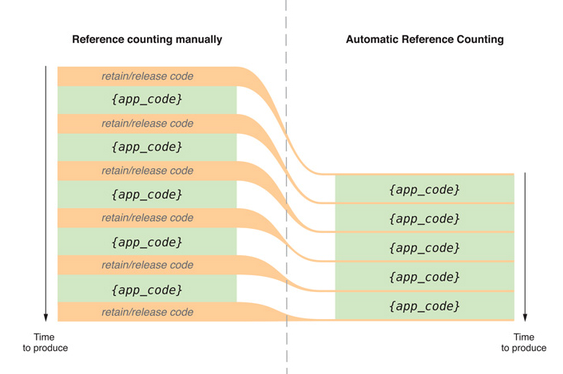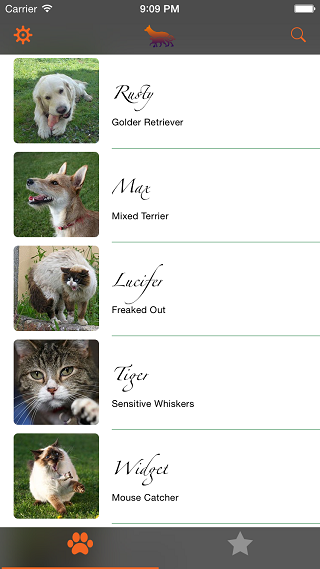IOS開發之內存管理–dealloc該寫些什麼
在非ARC開發環境中,dealloc是類釋放前,清理內存的最後機會。到底那些變量和屬性該釋放呢,一些特殊的類(nstimer,observer)該怎麼釋放。需要注意的是不釋放會引起內存洩露,過度釋放也會引起內存洩露,接下來會慢慢展開:
1 變量的釋放
變量聲明
@interface EnterHondaViewController : UIViewController{
UIImageView * imageLogo;
UIButton * btn_Corporate;
UIButton * btn_Brand;
CorporateView * corporateview;
BrandView * brandview;
}
變量初始化
@implementation EnterHondaViewController
-(id)initWithFrame:(CGRect)frame
{
self = [super init];
if (self) {
self.view.frame = frame;
[self.view setBackgroundColor:[UIColor whiteColor]];
UIImageView * background = [[UIImageView alloc] initWithFrame:CGRectMake(0, 0,1024, 768)];
[self.view addSubview:background];
[background release];
[background setImage:[UIImage imageNamed:@"AllAuto_Image_BG"]];
UIButton * backBtn = [[UIButton alloc]initWithFrame:CGRectMake(50, 18, 55,40)];
[backBtn setImage:[UIImage imageNamed:@"home_button"] forState:UIControlStateNormal];
[backBtn addTarget:self action:@selector(onBack:) forControlEvents:UIControlEventTouchUpInside];
[self.view addSubview:backBtn];
[backBtn release];
UILabel * titleLabel = [[UILabel alloc] initWithFrame:CGRectMake(160, 25, 400, 35)];
titleLabel.backgroundColor = [UIColor clearColor];
titleLabel.textAlignment = NSTextAlignmentLeft;
titleLabel.font = [UIFont fontWithName:@"Arial" size:30];
titleLabel.textColor = [UIColor colorWithRed:0.4 green:0.4 blue:0.4 alpha:1.0];
[self.view addSubview:titleLabel];
[titleLabel release];
[titleLabel setText:@"走進廣本"];
UIImageView * lineView = [[UIImageView alloc] initWithFrame:CGRectMake((frame.size.width-658)/2,70, 658, 8)];
lineView.image = [UIImage imageNamed:@"AllAuto_Config_TimeLine_BG"];
[self.view addSubview:lineView];
[lineView release];
UIView * logoview = [[UIView alloc] initWithFrame:CGRectMake(780, 80, 240, 25)];
[self.view addSubview:logoview];
[logoview release];
imageLogo = [[UIImageView alloc] initWithFrame:CGRectMake(0, 6, 12, 13)];
[logoview addSubview:imageLogo];
[imageLogo release];
imageLogo.image = [UIImage imageNamed:@"AllAuto_Corporation_Button_Select"];
btn_Corporate = [[UIButton alloc] initWithFrame:CGRectMake(13, 0, 100, 25)];
[logoview addSubview:btn_Corporate];
btn_Corporate.tag = 1;
[btn_Corporate release];
[btn_Corporate addTarget:self action:@selector(onOptionClick:) forControlEvents:UIControlEventTouchUpInside];
[btn_Corporate setTitle:@"企業文化" forState:UIControlStateNormal];
btn_Brand = [[UIButton alloc] initWithFrame:CGRectMake(133, 0, 100, 25)];
[logoview addSubview:btn_Brand];
btn_Brand.tag = 3;
[btn_Brand release];
[btn_Brand addTarget:self action:@selector(onOptionClick:) forControlEvents:UIControlEventTouchUpInside];
[btn_Brand setTitle:@"品牌故事" forState:UIControlStateNormal];
corporateview = [[CorporateView alloc] initWithFrame:CGRectMake(0, 110, frame.size.width, frame.size.height-120)];
brandview = [[BrandView alloc] initWithFrame:CGRectMake(0, 110, frame.size.width, frame.size.height-110)];
[btn_Corporate sendActionsForControlEvents:UIControlEventTouchUpInside];
[[NSNotificationCenter defaultCenter]addObserver:self selector:@selector(onGoBrandPage:) name:Notification_Navigate_To_Brand object:nil];
}
return self;
}
變量釋放
-(void)dealloc
{
[[NSNotificationCenter defaultCenter]removeObserver:self];
[brandview release];
[corporateview release];
[super dealloc];
}
2 屬性的釋放
屬性聲明
@interface GGDetailCell : UIGridViewCell {
}
@property (nonatomic, retain) UILabel *labelTitle;
@end
屬性初始化
- (id)init {
if (self = [super init]) {
self.frame = CGRectMake(0, 0, 66, 30.5);
{ // labelTitle
self.labelTitle = [[[UILabel alloc] initWithFrame:CGRectMake(0, 7, 66, 16)] autorelease];
[self.labelTitle setBackgroundColor:[UIColor clearColor]];
[self.labelTitle setTextColor:TEXT_COLOR_PART_NORMAL];
[self.labelTitle setFont:[UIFont systemFontOfSize:12]];
[self.labelTitle setNumberOfLines:0];
[self.labelTitle setTextAlignment:UITextAlignmentCenter];
[self addSubview:self.labelTitle];
}
}
return self;
}
屬性釋放
- (void)dealloc {
self.labelTitle = nil;
[super dealloc];
}
3 定時器的釋放
定時器聲明:
@interface BRLandscapeView
NSTimer* timer;
}
@end
定期初始化:
-(void) myInit{
{//set timer
timer = [NSTimer scheduledTimerWithTimeInterval: 1
target: self
selector: @selector(handleTimer:)
userInfo: nil
repeats: YES];
}
定時器釋放:如果實在view中聲明初始化的,要在 controller中view釋放前先釋放定時器,否則由於循環引用,而釋放不掉
@implementation BookReadController
-(void)dealloc
{
if (landscape) {
[landscape->timer invalidate];
}
SafeRelease(landscape);
[super dealloc];
}
@end
4 通知的釋放
-(void)dealloc
{
[[NSNotificationCenter defaultCenter]removeObserver:self];
[super dealloc];
}
5 delegate的釋放
delegate屬性的賦值一般為self,雖然聲明時assign,但在相關的view釋放時,在之前先釋放掉delegate
情況一
if (_loadingContentView) {
_loadingContentView.delegate = nil;
[_loadingContentView removeFromSuperview];
}
情況二
self.partGridView.uiGridViewDelegate = nil;
self.partGridView = nil;
6 有返回值的函數的內存管理
如果一個函數需要一個返回值,此返回值在函數內聲明和初始化,但缺不能立即釋放,最好的處理方式如下:
-(NSArray*)getTemplatesByPath:(NSString *)path
{
NSError * error = nil;
NSArray* files = [fileManager contentsOfDirectoryAtPath:path error:&error];
if(error != nil)
return nil;
NSMutableArray* resultArray = [NSMutableArray new];
for (NSInteger index=0; index < [files count]; index++)
{
NSString* fileName = [files objectAtIndex:index];
NSString* extType = [fileName pathExtension];
if(NO == [extType isEqualToString:@"tpl"])
continue;
[resultArray addObject:fileName];
}
return [resultArray autorelease];
}
擴展
1 變量初始化完,用完可立即釋放的情況
UIImageView * lineView = [[UIImageView alloc] initWithFrame:CGRectMake((frame.size.width-658)/2,70, 658, 8)];
lineView.image = [UIImage imageNamed:@"AllAuto_Config_TimeLine_BG"];
[self.view addSubview:lineView];
[lineView release];
2 聲明時,是聲明為變量還是屬性的考量。
在ios第一版中,我們為輸出口同時聲明了屬性和底層實例變量,那時,屬性是oc語言的一個新的機制,並且要求你必須聲明與之對應的實例變量,例如:
@interface MyViewController :UIViewController
{
UIButton *myButton;
}
@property (nonatomic, retain) UIButton *myButton;
@end
最近,蘋果將默認編譯器從GCC轉換為LLVM(low level virtual machine),從此不再需要為屬性聲明實例變量了。
如果LLVM發現一個沒有匹配實例變量的屬性,它將自動創建一個以下劃線開頭的實例變量。因此,在這個版本中,我們不再為輸出口聲明實例變量。
例如:
MyViewController.h文件
@interface MyViewController :UIViewController
@property (nonatomic, retain) UIButton *myButton;
@end
在MyViewController.m文件中
編譯器也會自動的生成一個實例變量_myButton
那麼在.m文件中可以直接的使用_myButton實例變量,也可以通過屬性self.myButton.都是一樣的。
注意這裡的self.myButton其實是調用的myButton屬性的getter/setter方法
這與c++中點的使用是有區別的,c++中的點可以直接訪問成員變量(也就是實例變量)
例如在oc中有如下代碼
.h文件
@interface MyViewController :UIViewController
{
NSString *name;
}
@end
.m文件中
self.name 這樣的表達式是錯誤的。xcode會提示你使用->,改成self->name就可以了。
因為oc中點表達式是表示調用方法,而上面的代碼中沒有name這個方法。
oc語法關於點表達式的說明:
"點表達式(.)看起來與C語言中的結構體訪問以及java語言匯總的對象訪問有點類似,其實這是oc的設計人員有意為之。
如果點表達式出現在等號 = 左邊,該屬性名稱的setter方法將被調用。如果點表達式出現在右邊,該屬性名稱的getter方法將被調用。"
所以在oc中點表達式其實就是調用對象的setter和getter方法的一種快捷方式, 例如:
dealie.blah = greeble 完全等價於 [dealie.blah setBlah:greeble];
以前的用法,聲明屬性跟與之對應的實例變量:
@interface MyViewController :UIViewController
{
UIButton *myButton;
}
@property (nonatomic, retain) UIButton *myButton;
@end
這種方法基本上使用最多,現在大部分也是在使用,因為很多開源的代碼都是這種方式。
但是ios5更新之後,蘋果是建議以以下的方式來使用
@interface MyViewController :UIViewController
@property (nonatomic, retain) UIButton *myButton;
@end
因為編譯器會自動為你生成以下劃線開頭的實例變量_myButton。不需要自己手動再去寫實例變量。
而且也不需要在.m文件中寫@synthesize myButton;也會自動為你生成setter,getter方法。
@synthesize的作用就是讓編譯器為你自動生成setter與getter方法。
它還有一個作用,可以指定與屬性對應的實例變量,
例如@synthesize myButton = xxx;
那麼self.myButton其實是操作的實例變量xxx,而不是_myButton了。
在實際的項目中,我們一般這麼寫.m文件
@synthesize myButton;
這樣寫了之後,那麼編譯器會自動生成myButton的實例變量,以及相應的getter和setter方法。
注意:_myButton這個實例變量是不存在的,因為自動生成的實例變量為myButton而不是_myButton。
所以現在@synthesize的作用就相當於指定實例變量,
如果.m文件中寫了@synthesize myButton;那麼生成的實例變量就是myButton。
如果沒寫@synthesize myButton;那麼生成的實例變量就是_myButton。
所以跟以前的用法還是有點細微的區別。
注意:這裡與類別中添加的屬性要區分開來,因為類別中只能添加方法,不能添加實例變量。
經常會在ios的代碼中看到在類別中添加屬性,這種情況下,是不會自動生成實例變量的。
比如在
UINavigationController.h文件中會對UIViewController類進行擴展
@interface UIViewController (UINavigationControllerItem)
@property(nonatomic,readonly,retain) UINavigationItem *navigationItem;
@property(nonatomic) BOOL hidesBottomBarWhenPushed;
@property(nonatomic,readonly,retain) UINavigationController *navigationController;
@end
這裡添加的屬性,不會自動生成實例變量,這裡添加的屬性其實是添加的getter與setter方法。
注意一點,匿名類別(匿名擴展)是可以添加實例變量的,非匿名類別是不能添加實例變量的,只能添加方法,或者屬性(其實也是方法)。
ARC
關於強引用,弱引用,arc的使用可以查看文件ios5arc完全指南。
ios5引進的arc確實方便了很多,ARC 的規則非常簡單:
只要還有一個變量指向對象,對象就會保持在內存中。當指針指向新值,或者指針不再存在時,相關聯的對象就會自動釋放。
這條規則對於實例變量、synthesize 屬性、本地變量都是適用的。
以前沒有arc的時候,必須調用
dealloc方法來釋放內存,比如:
- (void)dealloc {
[_myTableView release];
[superdealloc];
}
如果使用了ARC,那麼將不再需要dealloc方法了,也不需要再擔心release問題了。系統將自動的管理內存。
- 上一頁:iOS動畫技術筆記
- 下一頁:IOS — 日期時間格式 轉換




